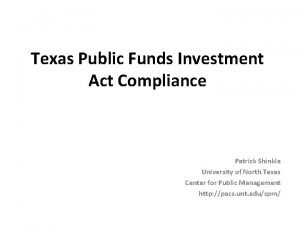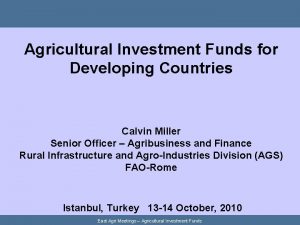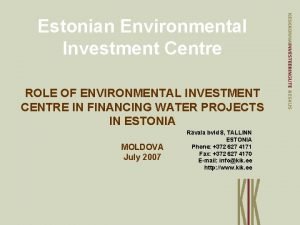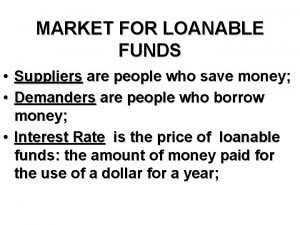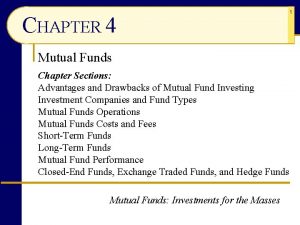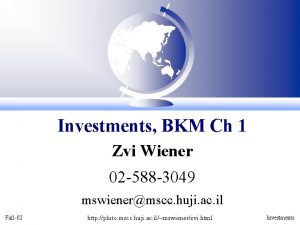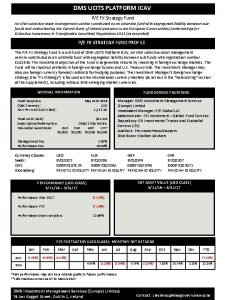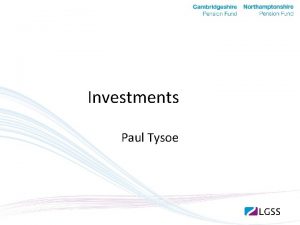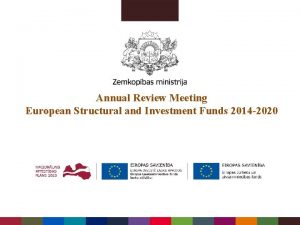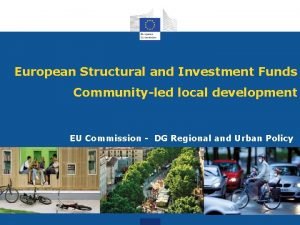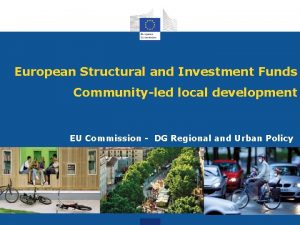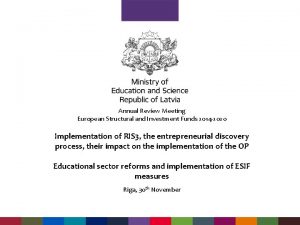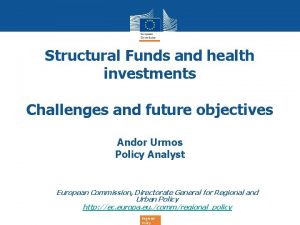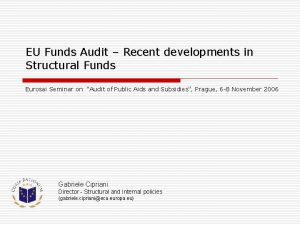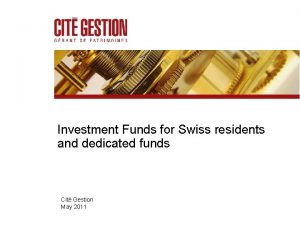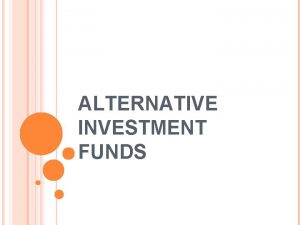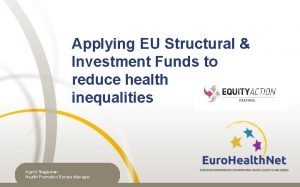European Structural and Investment Funds ICT investments State






















- Slides: 22

European Structural and Investment Funds & ICT investments State of Play Katja Reppel G. 1 CC smart and sustainable growth & senior experts for smart growth

Basics on current Cohesion Policy € 347 billion in 2007 -13 COHESION POLICY = • Regional & Urban Policy: ia: ients p i c e bursed v r l a Dis. ERDF, incl. INTERREG, Cohesion Fund u individ o t – s t (“basic” infrastructures) n a - Gr nsortia ESF • Social ans, o l ( s and co. Policy: t n e instrum l OTHER POLICIES RELATED TO COHESION a i c n a illion = n i b F 2 1 € = • Common Agricultural Policy and Rural tees) e h t C, guaran n i V ( F D R E f Development (EAFRD) o und 5. 5% o r a • Common Fisheries Policy (EMFF) 0%) round a future: 1 : t n e m procure c i l b u P billion 0 6 1 € e m % = so objective: regions with ibility s 46 Convergence a e f , s e c GDP per capita under 75% of the EU t servi r o p orks … p u w t S e n average. 81. 5% of the funds are spent & s tform udies, pla ance ston this objective. assist l a c i n h c e - T Regional competitiveness and employment objective. Regional Policy 455 Opera tional Progra … and mmes almos t as m Manag a Progra ing Authori ny ties mmes less 5 a r e mor 0/50 a e or t natio n region al leve al vs. l

Planned investments of total ERDF and Cohesion Fund (€ 271 billion): Unlocking growth potential by promoting research and innovation in all regions: Environment € 86 billion for research and In less developed innovation, over 25% of total Transportregions, ERDF is the cohesion policy budget: most important - R&I capacity-building and source of funding for infrastructure: over € 50 billion research and - Entrepreneurship: over € 8. 3 billion innovation! - ICT capacities, research and takeup: over € 13 billion - Human capital for innovation: over Research/Innovation € 14. 5 billion Information society Social infrastructure Energy Tourism Culture Institutional capacity Regional Policy

Basics on current Cohesion Policy Funds allocated to ICTs in 2007 -13: • • over EUR 15 billion or 4. 4% of the total cohesion policy budget. Shift in the investment priorities from infrastructure to support for content development, both in the public sector (e. Health, e. Government, etc. ) and for SMEs (e. Learning, e. Business, etc. ) "AB SO RPT ION "P RO BLE MS ! Cohesion Regional Policy

State of Play: Cohesion Policy achievements since 2007 • More than 15 900 cooperation project enterprises – research institutions. • More than 15 600 Research jobs created. PT used the indicator but did not report achievements for 2011. But 8 MS did not use the jobs indicator, including some which devote significant resources to this thematic area (ES, GR, SI). BG, LV, SK reported zero achievements. • More than 20 700 ICT projects • More than 53 100 start-ups See Strategic Report 2013: http: //ec. europa. eu/regional_policy/how/policy/strategic_report_en. cf m#sr 2013 5 Regional Policy

Examples for ICT related Cohesion Policy investments INTERREG networks for policy learning in the field of ICT: http: //i 4 c. eu/approved_projects. html B 3 Regions: Regions for Better Broadband connection: spreading good practices of the expert partners relating to broadband implementation in disadvantaged areas and share experience with Managing Authorities and ICT agencies willing to implement successful broadband strategies with Structural Fund support. IMMODI: Making the most of good practice in e-Government and e-health, which contribute to the development of mountain and rural areas. Selected examples are presented at technical and regional workshops, detailed in a published guide and discussed with Managing Authorities in order to transfer them into the regional development programmes of participating regions PIKE: Promoting Innovation and the Knowledge Economy: to improve regional and local Innovation & Knowledge Economy policies through the exchange and transfer of examples of e-Government and Wireless Broadband good practice, and through the integration of these into the development policies of participating regions. See guide: http: //ipts. jrc. europa. eu/activities/research-andinnovation/documents/broadband 2011_en. pdf Regional Policy

Financial engineering for IT firms: JOint Sm. E Finance for INovation (JOSEFIN): To help knowledge-based SMEs in the Baltic Sea region expand internationally, the JOSEFIN project introduced a range of practical instruments designed to support them, including a European counter guarantee and a new risk-sharing model. See: www. josefin-org. eu ERDF contribution: € 2. 9 million (January 2009 to January 2012) JEREMIE Holding Fund, Andalucia, Spain: The Innovation and Development Agency of Andalucia has put up a JEREMIE Holding Fund in 2009. The fund has a size of € 235 m million (70% from ERDF and 30% from the Ministry of Economy, Innovation and Science of Andalusia). It consists of a MULTI-INSTRUMENT FUND (€ 185 m) and a VENTURE CAPITAL FUND (€ 50 m). At the end of 2010 the fund had already invested € 68 m in 22 enterprises. These investments leveraged a total of € 220 m of new investment in these companies based on an average co-investment rate of 78% and a multiplier of 4. 6, resulting in 3. 060 new jobs and supporting 2. 500 existing jobs. See: http: //www. agenciaidea. es/fondos-reembolsables ERDF contribution: € 164, 5 million Cohesion Regional Policy

Future of Cohesion Policy 2014 -2020 ü Deliver Europe 2020 ü Strengthen partnership ü Simplification ü Focus on results, not spending ü Maximise the impact of EU funding Regional Policy

Billion EUR Less developed regions 164. 3 Transition regions 31. 7 More developed regions 49. 5 Cohesion Fund 66. 4 European territorial cooperation 8. 9 Of which Cross border cooperation 6. 6 Transnational cooperation 1. 8 Interregional cooperation 0. 5 Outermost regions and northern sparsely populated regions 1. 4 Youth Employment initiative 3. 0 TOTAL 325. 1 Regional Policy

Billion EUR Less developed regions Transition regions 31. 7 More developed regions 49. 5 Cohesion Fund 66. 4 European territorial cooperation Up to € 10 0 billion fo innovatio n investm r bolsterin ents g over 15 0 smart specialis ation stra tegies, Digital gr owth stra tegies and NGN Plans 164. 3 8. 9 Of which Cross border cooperation 6. 6 Transnational cooperation 1. 8 Interregional cooperation 0. 5 Outermost regions and northern sparsely populated regions 1. 4 Youth Employment initiative 3. 0 TOTAL 325. 1 Regional Policy

sustainable inclusive Europe 2020 smart Thematic objectives 1. Research and innovation 2. Information and Communication Technologies 3. Competitiveness of Small and Medium-Sized Enterprises (SME) 4. Shift to a low-carbon economy 5. Climate change adaptation and risk management and prevention 6. Environmental protection and resource efficiency 7. Sustainable transport and disposal of congestion on major network infrastructure 8. Employment and support for labour mobility 9. Social inclusion and poverty reduction 10. Education, skills and lifelong learning 11. Increased institutional capacity and effectiveness of public administration Regional Policy

Thematic Concentration … and evermore need to concentrate on investments on themes that enable smart & sustainable growth Research and Innovation Energy efficiency and renewable energy SMEs competitiveness Developed regions and transition regions Less developed regions Flexibility (different regions present different needs) Special arrangements for the previously convergence regions Cohesion Regional Policy

Thematic concentration of the ERDF Research and Innovation SMEs competitiveness Energy efficiency and renewable energy + ICT access, quality and use Concentration on "two or more of thematic objectives 1, 2, 3 and 4" Developed regions and transition regions Transition regions: 60 % 12% Less developed regions concentration (incl. Flexibility 15% for(different regions present different needs) energy/renewables) Special arrangements for the previously convergence regions Regional Policy

Thematic concentration in Cohesion Policy SME competitiveness Energy n reme rocu ve p c i l Pub innovati of ions solut t ion vat no o-in Ec s es sin bu els w Ne mod ip rsh neu e r rep ills Ent sk ls Smart Grids Innovation R&I infrastructures Public sector Innovation +admin. capacity kil E-s erce m -com E Human Capital Skills Mobility ta Da n pe O ers nt e ov E-g e rnm ICT Broadband Regional Policy Re se h arc

Thematic Objective 2 translates into ERDF Investment Priority 2: Enhancing access to + use and quality of ICT Investment priorities under TO 2: Ex ante conditionalities: a) diffusion of broadband high speed networks, supporting adoption of emerging technologies and networks for the digital economy b) development of ICT products and services, electronic commerce and increased demand for ICT c) strengthening the application of ICT for e. Government, e. Learning, e. Inclusion and e. Health Regional Policy Next Generation Access Plan Strategic policy framework for digital growth (also in RIS 3)

Ex ante conditionality for IP 2 bc Final result of the trilogue: Thematic objectives Enhancing access to and use and quality of information and communication technologies (Broadband target) Investment priorities ERDF: Ex ante conditionality 2. 1 Digital growth : A strategic policy - developing ICT framework for digital products and growth to stimulate services, eaffordable, good quality commerce and interoperable ICTenhancing demand enabled private and for ICT public services and increase uptake by - strengthening ICT citizens, including (referred to in applications for evulnerable groups, government, e. Article 9(2)) businesses and public learning, e-inclusion, administrations e-culture and eincluding cross border health initiatives. Criteria for fulfilment A strategic policy framework for digital growth, for instance, within the national or regional smart specialisation strategy is in place that contains: – budgeting and prioritisation of actions through a SWOT or similar analysis consistent with the Scoreboard of the Digital Agenda for Europe; – an analysis of balancing support for demand supply of information and communication technologies (ICT) should have been conducted; – indicators to measure progress of interventions in areas such as digital literacy, einclusion, e-accessibility, and of e-health within the limits of Article 168 TFEU which are aligned with existing relevant sectoral Union, national or regional strategies; – assessment of needs to reinforce ICT capacity-building. 16 Regional Policy

Ex ante conditionality for IP 2 a Final result of the trilogue: Thematic objectives 2. Enhancing access to and use and quality of information and communication technologies (Broadband target) (referred to in Article 9(2)) Investment priorities ERDF: –extending broadband deployment and the roll-out of high-speed networks and supporting the adoption of future and emerging technologies and networks for the digital economy Ex ante conditionality Criteria for fulfilment 2. 2 Next Generation Network (NGN) Infrastructure: The existence of national or regional NGN Plans which take account of regional actions in order to reach the EU high-speed Internet access targets, focusing on areas where the market fails to provide an open infrastructure at an affordable cost and to a quality in line with the EU competition and state aid rules, and provide accessible services to vulnerable groups. A national and/or regional NGN Plan is in place that contains: Regional Policy – a plan of infrastructure investments based on an economic analysis taking account of existing private and public infrastructures and planned investments; – sustainable investment models that enhance competition and provide access to open, affordable, quality and future proof infrastructure and services; – measures to stimulate private investment. 17

What other investment priorities are ICT relevant? Investment Priority 1 result of trilogue in July 1. strengthening research, technological development and innovation through: (a) enhancing research and innovation (R&I) infrastructure and capacities to develop R&I excellence and promoting centres of competence, in particular those of European interest; (b) promoting business investment in innovation and research, and developing links and synergies between enterprises, R&D centres and higher education, in particular product and service development, technology transfer, social innovation, eco-innovation, public service applications, demand stimulation, networking, clusters and open innovation through smart specialisation and supporting technological and applied research, pilot lines, early product validation actions, advanced manufacturing capabilities and first production, in particular in Key Enabling Technologies and diffusion of general purpose technologies, Regional Policy

What other investment priorities are ICT relevant? Investment Priority 3 result of trilogue in July enhancing the competitiveness of SMEs through: (a) promoting entrepreneurship, in particular by facilitating the economic exploitation of new ideas and fostering the creation of new firms, including through business incubators; (b) developing and implementing new business models for SMEs, in particular for internationalisation; (c) supporting the creation and the extension of advanced capacities for product and service development; (d) supporting the capacity of SMEs to engage in growth in regional, national and international markets, and in innovation processes; Regional Policy

What other investment priorities are ICT relevant? Investment Priority 4 result of trilogue in July Low-carbon economy (4) supporting the shift towards a low-carbon economy in all sectors through: (a) promoting the production and distribution of energy derived from renewable sources; (b) promoting energy efficiency and renewable energy use in enterprises; (c) supporting energy efficiency, smart energy management and renewable energy use in public infrastructures, including in public buildings, and in the housing sector; (d) developing and implementing smart distribution systems at low and medium voltage levels; promoting low-carbon strategies for all types of territories, in particular for urban areas, including the promotion of sustainable multi-modal urban mobility and mitigation relevant adaptation measures; (e) promoting research in, innovation in and adoption of low-carbon technologies; (f) promoting the use of high-efficiency co-generation of heat and power based on useful heat demand, 20 Regional Policy

State of play in negotiations Partnership Agreements • Informal drafts received & ISC finalised: 14 MS ( FI, HU, SK, SE, SI, DK, LV, EE, LT, CZ, DE, PL, BG, NL ) • ISC by mid-Dec if draft PA sufficiently developed: 10 MS (RO, LU, PT, ES, EL, UK, AT, FR, BE, MT ) • No time for informal check: IT, CY, IE, HR • Problems: incomplete, inconsistent, attempts of "business as usual" Operational Programmes: around 10 -15% received as informal drafts – Problems: no intervention logic, X-mas treeing, retro-fitting … Conclusions: Implement as many different types of measure as possible in support of the Information Society, provided they are in line with the local/regional needs and context Regional Policy

Which fields of specialisation emerge in the RIS 3 analysis? Most frequ ently cited fields of RIS 3 are related to: • Energy • Life scien ce • ICT • Environm ent • Agro-food • Tourism • New mate rials Cohesion Regional Policy See: http: //s 3 platform. jrc. europa. eu/eyeris 3; jsessionid=87 sk. R 80 Jmq. XZLl. Whx. L 8 Zvy. H 9 XYk. GRTg 62 j 2 k 1 YVkct. XQR 0 t. Ry. Wg. Q!1058177620!1362916436845 Regions and MS can indcate envisaged fields fo spacialisation and identify partners for cooperation
 Public funds investment act training
Public funds investment act training Agricultural investment funds for developing countries
Agricultural investment funds for developing countries Fixed investment and inventory investment
Fixed investment and inventory investment European green deal investment plan
European green deal investment plan Eic european investment centre
Eic european investment centre Investments and securities tribunal
Investments and securities tribunal Chapter 11 real estate and other investments
Chapter 11 real estate and other investments Sources and uses of funds
Sources and uses of funds Shareholders equity and shareholders funds
Shareholders equity and shareholders funds Supply and demand of loanable funds
Supply and demand of loanable funds Shifters of loanable funds
Shifters of loanable funds Fund of funds example
Fund of funds example Kebutuhan dana
Kebutuhan dana Equity accounted investments
Equity accounted investments Fundamentals of analyzing real estate investments
Fundamentals of analyzing real estate investments Intermediate accounting chapter 17 investments solutions
Intermediate accounting chapter 17 investments solutions 02 588
02 588 Investments bodie kane marcus
Investments bodie kane marcus Loarre investments
Loarre investments Pe investments fx strategy
Pe investments fx strategy Morepower
Morepower Investments bodie kane marcus summary
Investments bodie kane marcus summary Chapter 10 basics of saving and investing
Chapter 10 basics of saving and investing
